What is your favorite book? Is it a book from your childhood? Is it a book that a teacher read aloud to you? Is it a book that you have successfully used in your teaching? Or is it a book that you have recently read? Why is it your favorite and how do you share your favorite books with your students, friends and colleagues? This week members of the International Reading Association Children's Literature and Reading Special Interest Group (CL/R SIG) continue to share some of our favorite 2012 titles.
GRADES K-3
Brennan-Nelson, Denise. (2012). Maestro Stu saves the zoo. Illus. by Tim Bowers. Ann Arbor, MI: Sleeping Bear Press.
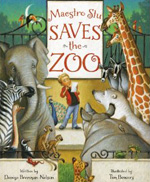 A primer on the use of commonly employed idioms as well as an amusing story about the triumph of the weak and seemingly helpless over the powerful, this picture book would be especially useful for anyone learning to speak English fluently. The idioms are sprinkled generously throughout the story and are then listed with an explanation of their meanings in the book’s back matter. The story itself revolves around Stu whose proximity to the zoo allows him to savor the sounds of the captive animals from his home each evening. When an untrustworthy businessman, Mr. Cooper, devises plans to turn the zoo into a mall, Stu concocts his own plan to amplify the animals' musical notes and conduct "a symphony of sounds" (unpaged) so that the area’s residents will pay attention. His plan works, and the animals receive a great deal of publicity and attendance at the zoo skyrockets. Mr. Cooper is forced to abandon his plans, and he gets his just desserts with a job cleaning up after all the animals. Young readers will love the message, Stu's quick and creative thinking, and the animals themselves with their "squeaks and bellows, gurgles and chirps" (unpaged), all proof that there’s more than one way to skin a cat, to use another idiom not included in the book. Interested readers can find even more English language idioms at Dave’s ESL Café. Read more about Denise Brennan-Nelson in the "5 Questions With..." interview on the Engage blog.
A primer on the use of commonly employed idioms as well as an amusing story about the triumph of the weak and seemingly helpless over the powerful, this picture book would be especially useful for anyone learning to speak English fluently. The idioms are sprinkled generously throughout the story and are then listed with an explanation of their meanings in the book’s back matter. The story itself revolves around Stu whose proximity to the zoo allows him to savor the sounds of the captive animals from his home each evening. When an untrustworthy businessman, Mr. Cooper, devises plans to turn the zoo into a mall, Stu concocts his own plan to amplify the animals' musical notes and conduct "a symphony of sounds" (unpaged) so that the area’s residents will pay attention. His plan works, and the animals receive a great deal of publicity and attendance at the zoo skyrockets. Mr. Cooper is forced to abandon his plans, and he gets his just desserts with a job cleaning up after all the animals. Young readers will love the message, Stu's quick and creative thinking, and the animals themselves with their "squeaks and bellows, gurgles and chirps" (unpaged), all proof that there’s more than one way to skin a cat, to use another idiom not included in the book. Interested readers can find even more English language idioms at Dave’s ESL Café. Read more about Denise Brennan-Nelson in the "5 Questions With..." interview on the Engage blog.
- Barbara A. Ward, Washington State University Pullman
Burleigh, Robert. (2012). Hit the road Jack. Illus. by Ross MacDonald. New York: Abrams.
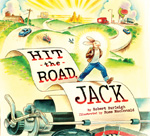 Readers follow Jack, a jackrabbit portrayed as a human, across America. The Jack of this book loosely represents the spirit of author, Jack Kerouac, who loved to travel and write. As the character Jack roams across the U.S. he glories in each region he discovers. He loves the small towns and the cities and the people he finds there. MacDonald’s watercolors and penciled crayons reflect the soft glow of nature and life on the road for Jack. Set in a 1950’s style America and written in a Beat poetry style, this book pays homage to Kerouac while encouraging a love of country, writing and wanderlust through Jack. Visit the author’s website and learn how you can Skype with this author. Teachers might like to connect the ReadWriteThink idea: “Have Journal … Will Travel: Promoting Family Involvement in Literacy.”
Readers follow Jack, a jackrabbit portrayed as a human, across America. The Jack of this book loosely represents the spirit of author, Jack Kerouac, who loved to travel and write. As the character Jack roams across the U.S. he glories in each region he discovers. He loves the small towns and the cities and the people he finds there. MacDonald’s watercolors and penciled crayons reflect the soft glow of nature and life on the road for Jack. Set in a 1950’s style America and written in a Beat poetry style, this book pays homage to Kerouac while encouraging a love of country, writing and wanderlust through Jack. Visit the author’s website and learn how you can Skype with this author. Teachers might like to connect the ReadWriteThink idea: “Have Journal … Will Travel: Promoting Family Involvement in Literacy.”
- Karen Hildebrand, Ohio Library and Reading Consultant
Coffelt, Nancy (2012). Aunt Ant leaves through the leaves. New York: Holiday House.
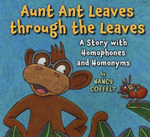 Unable to use a tractor to move all the bananas he plans to use to bake banana pies, a monkey asks for help, but he is turned down by an ant, a bee, a bear, and a gnu, among other animals. Each one is too preoccupied to help and sends him on to another potential helper. After shouting himself hoarse, he meets a horse who is “hey, too tired” (unpaged) and wants some hay. Finally, just when the monkey is ready to work by himself, Aunt Ant comes to the rescue. Back home, the animals make creamy banana pies which they consume. The animals even return to help remove the peels and clean up. The author cleverly takes every opportunity in the story to place homophones and homonyms in the context of the story. The end note provides explanations of the homophones and homonyms found in the text. The book is a good addition for language arts classes and school classroom libraries. Students can be encouraged to create a play to enact the story. Most importantly, it provides an entertaining way for English language learners of all ages to learn about the idiosyncrasies of the English language.
Unable to use a tractor to move all the bananas he plans to use to bake banana pies, a monkey asks for help, but he is turned down by an ant, a bee, a bear, and a gnu, among other animals. Each one is too preoccupied to help and sends him on to another potential helper. After shouting himself hoarse, he meets a horse who is “hey, too tired” (unpaged) and wants some hay. Finally, just when the monkey is ready to work by himself, Aunt Ant comes to the rescue. Back home, the animals make creamy banana pies which they consume. The animals even return to help remove the peels and clean up. The author cleverly takes every opportunity in the story to place homophones and homonyms in the context of the story. The end note provides explanations of the homophones and homonyms found in the text. The book is a good addition for language arts classes and school classroom libraries. Students can be encouraged to create a play to enact the story. Most importantly, it provides an entertaining way for English language learners of all ages to learn about the idiosyncrasies of the English language.
- Rani Iyer, Washington State University Pullman
Fleming, Candace. (2012). Oh, No! Illus. by Eric Rohmann. New York: Random House/Schwartz & Wade Books.
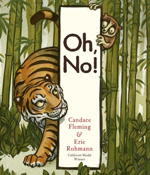 Parents and teachers who would like to take their youngsters on a field trip to the jungles of Asia without ever leaving their homes or classrooms may find this book to be an excellent companion. The story begins simply enough. A frog falls into a deep hole. His cry for help is heard by a mouse that is too small to help. Still, she reaches down, and she too falls into the hole. One by one, other animals, including a slow Loris, a monkey, and a sun bear, join the mouse and the frog. Along comes the hungry tiger, licking his teeth at the tasty feast that awaits him. Just then, the ground rumbles and quakes as an elephant comes to aid his friends. The tiger falls from his perch into the hole. Now, the tiger is in the hole and desperately pleads for help. The illustrations provide emotive expressions for the creatures, capturing the rainforest habitat with bold and masterful strokes. The accompanying text is brief but filled with word play; for instance, when the mouse falls in the hole, she calls out, “Pippa-eeek!” (unpaged), while Tiger later licks his teeth with a “slop-slurp” (unpaged). The sounds add great context for reader participation. The free verse style invites readers to pay attention to the experience evoked by words. This book is highly recommended for lap-reading with kids or classroom reading when children are allowed to move as they repeat the sounds. The “Oh, no!” refrain adds to the story’s charm.
Parents and teachers who would like to take their youngsters on a field trip to the jungles of Asia without ever leaving their homes or classrooms may find this book to be an excellent companion. The story begins simply enough. A frog falls into a deep hole. His cry for help is heard by a mouse that is too small to help. Still, she reaches down, and she too falls into the hole. One by one, other animals, including a slow Loris, a monkey, and a sun bear, join the mouse and the frog. Along comes the hungry tiger, licking his teeth at the tasty feast that awaits him. Just then, the ground rumbles and quakes as an elephant comes to aid his friends. The tiger falls from his perch into the hole. Now, the tiger is in the hole and desperately pleads for help. The illustrations provide emotive expressions for the creatures, capturing the rainforest habitat with bold and masterful strokes. The accompanying text is brief but filled with word play; for instance, when the mouse falls in the hole, she calls out, “Pippa-eeek!” (unpaged), while Tiger later licks his teeth with a “slop-slurp” (unpaged). The sounds add great context for reader participation. The free verse style invites readers to pay attention to the experience evoked by words. This book is highly recommended for lap-reading with kids or classroom reading when children are allowed to move as they repeat the sounds. The “Oh, no!” refrain adds to the story’s charm.
- Rani Iyer, Washington State University Pullman
Pittau, Francisco, & Gervais, Bernadette. (2012). Birds of a feather. San Francisco: Chronicle Books.
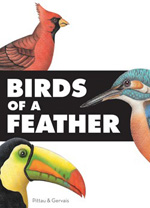 This over-sized book is filled with black-and-white aviary illustrations and color-drenched lift-the-flap devices and black jigsaw puzzle pieces that reveal information about various birds, such as the grey crowned crane and the ostrich. The format and the subject matter are likely to keep young readers occupied for long periods of time as they flip through the pages featuring different bird feathers which can be lifted to reveal the type of bird associated with each feather and an interesting bird fact. Even adults will fall in love with the two pages filled with actual bird eggs that can be lifted for information about the bird to which the egg belongs. Readers will enjoy trying to guess the birds from their silhouettes and eggs. This is a must-have for an elementary science classroom if teachers are willing to let the book leave their own clutches.
This over-sized book is filled with black-and-white aviary illustrations and color-drenched lift-the-flap devices and black jigsaw puzzle pieces that reveal information about various birds, such as the grey crowned crane and the ostrich. The format and the subject matter are likely to keep young readers occupied for long periods of time as they flip through the pages featuring different bird feathers which can be lifted to reveal the type of bird associated with each feather and an interesting bird fact. Even adults will fall in love with the two pages filled with actual bird eggs that can be lifted for information about the bird to which the egg belongs. Readers will enjoy trying to guess the birds from their silhouettes and eggs. This is a must-have for an elementary science classroom if teachers are willing to let the book leave their own clutches.
- Barbara A. Ward, Washington State University Pullman
Smith, Lane. (2012). Abe Lincoln’s dream. New York: Roaring Brook Press.
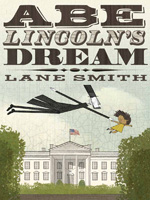 Smith sets the tone for this book in the opening wordless panels with a frightened dog (Roosevelt’s Scottish terrier, Fala) roaming the White House. The reader learns that other Presidential dogs were afraid in the White House as well, especially terrified of one particular bedroom. The story line then changes to a school tour of the White House on President’s Day. However, one young girl, Quincy, has slipped away from the school group when she spies a very tall pale man in a stovepipe hat walking through a wall. At that moment, Quincy meets the ghost of Abraham Lincoln. Through simple humor and complex questions Quincy and Abe become friends and she brings Mr. Lincoln up to date on what has been happening since 1865. President Lincoln was so worried about the state of the nation at the moment of his untimely death. Hand in hand, Quincy and President Lincoln fly over many national monuments until Abe is feeling better about the current state of affairs in the country. A beautifully told story with subtle illustrations and varying sizes of typography create an atmosphere of quiet reflection that Lincoln has fulfilled his dream of unity. Teachers might like to introduce the book with this very well done book trailer or visit the author’s website.
Smith sets the tone for this book in the opening wordless panels with a frightened dog (Roosevelt’s Scottish terrier, Fala) roaming the White House. The reader learns that other Presidential dogs were afraid in the White House as well, especially terrified of one particular bedroom. The story line then changes to a school tour of the White House on President’s Day. However, one young girl, Quincy, has slipped away from the school group when she spies a very tall pale man in a stovepipe hat walking through a wall. At that moment, Quincy meets the ghost of Abraham Lincoln. Through simple humor and complex questions Quincy and Abe become friends and she brings Mr. Lincoln up to date on what has been happening since 1865. President Lincoln was so worried about the state of the nation at the moment of his untimely death. Hand in hand, Quincy and President Lincoln fly over many national monuments until Abe is feeling better about the current state of affairs in the country. A beautifully told story with subtle illustrations and varying sizes of typography create an atmosphere of quiet reflection that Lincoln has fulfilled his dream of unity. Teachers might like to introduce the book with this very well done book trailer or visit the author’s website.
- Karen Hildebrand, Ohio Library and Reading Consultant
Yolen, Jane. (2012). Waking dragons. Illus. by Derek Anderson. New York: Simon and Schuster.
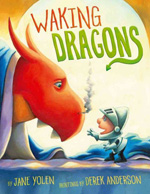 Jane Yolen’s poem about young dragons is the perfect vehicle for the bright acrylic illustrations of Derek Anderson. Used as a read aloud or a cozy lap book, this simple look at getting up in the morning dragon-style is a fun way to look at morning routines. Anderson’s illustrations define extending the text in a picture book as most of the real action takes place in the illustrations. The young knight throughout the story provides a whole other story within the story. A delightful romp! Teachers will enjoy the activity sheet provided by the publisher or try ReadWriteThink’s “Add Seasons to Rhyming Poems and Songs.”
Jane Yolen’s poem about young dragons is the perfect vehicle for the bright acrylic illustrations of Derek Anderson. Used as a read aloud or a cozy lap book, this simple look at getting up in the morning dragon-style is a fun way to look at morning routines. Anderson’s illustrations define extending the text in a picture book as most of the real action takes place in the illustrations. The young knight throughout the story provides a whole other story within the story. A delightful romp! Teachers will enjoy the activity sheet provided by the publisher or try ReadWriteThink’s “Add Seasons to Rhyming Poems and Songs.”
- Karen Hildebrand, Ohio Library and Reading Consultant
GRADES 4-6
Kimmel, Eric. (2012). Hiss-s-s-s! New York: Holiday House.
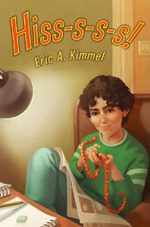 Omar is a fourth-grade Muslim American boy who desperately wants a snake, much to the dismay of his mother who is terrified of snakes. When he finally convinces his parents that he will be absolutely responsible for the entire care of the snake, they relent. Omar researches snakes in depth and when a visit to the Snake Dude convinces him that a corn snake is the right choice, Omar and his father take the snake home. Predictably, the snake escapes in the house and Omar does everything imaginable to keep this fact from his mother. Reluctant or emerging reader snake-lovers will enjoy this book and much detailed information of snakes is intertwined within the text. Teachers will get ideas about snakes and other nontraditional pets at ReadWriteThink’s podcast entitled, “Unusual Pets.” Read from the author’s blog about writing this book. For the real snake lovers, drop by All About Corn Snakes.
Omar is a fourth-grade Muslim American boy who desperately wants a snake, much to the dismay of his mother who is terrified of snakes. When he finally convinces his parents that he will be absolutely responsible for the entire care of the snake, they relent. Omar researches snakes in depth and when a visit to the Snake Dude convinces him that a corn snake is the right choice, Omar and his father take the snake home. Predictably, the snake escapes in the house and Omar does everything imaginable to keep this fact from his mother. Reluctant or emerging reader snake-lovers will enjoy this book and much detailed information of snakes is intertwined within the text. Teachers will get ideas about snakes and other nontraditional pets at ReadWriteThink’s podcast entitled, “Unusual Pets.” Read from the author’s blog about writing this book. For the real snake lovers, drop by All About Corn Snakes.
- Karen Hildebrand, Ohio Library and Reading Consultant
Lewis, J. Patrick and Jane Yolen. (2012). Last laughs: Animal epitaphs. Illus. by Jeffrey Stewart Timmins. Watertown, MA: Charlesbridge.
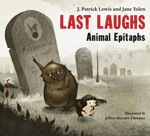 “Here at Amen/ Creature Corners,/ beasties weep/ like misty mourners/ but when they read/ an epitaph,/ it always brings them/ one last laugh./ Forget the hankies./ Read the words/ of bugs and fishes,/ beasts and birds./ They know it’s not/ all gloom and doom/ that’s written/ once upon a tomb./ (page 5) This epitaph opens the book and sets the mood with this title poem, “Last Laughs.” The poems are loosely grouped by animal type. Though Timmin’s delightful illustrations are dark and shadowy, readers will find humor in each epitaph. This will be a great poetry book to share at this time of year and serve as a writing model for student written epitaphs. Visit our Children’s Poet Laureate website and unpack his poetry toolbox. The IRA Engage blog has "5 Questions With... J. Patrick Lewis and Jane Yolen," and try ReadWriteThink’s “Poetry: A Feast to Form Fluent Readers.”
“Here at Amen/ Creature Corners,/ beasties weep/ like misty mourners/ but when they read/ an epitaph,/ it always brings them/ one last laugh./ Forget the hankies./ Read the words/ of bugs and fishes,/ beasts and birds./ They know it’s not/ all gloom and doom/ that’s written/ once upon a tomb./ (page 5) This epitaph opens the book and sets the mood with this title poem, “Last Laughs.” The poems are loosely grouped by animal type. Though Timmin’s delightful illustrations are dark and shadowy, readers will find humor in each epitaph. This will be a great poetry book to share at this time of year and serve as a writing model for student written epitaphs. Visit our Children’s Poet Laureate website and unpack his poetry toolbox. The IRA Engage blog has "5 Questions With... J. Patrick Lewis and Jane Yolen," and try ReadWriteThink’s “Poetry: A Feast to Form Fluent Readers.”
- Karen Hildebrand, Ohio Library and Reading Consultant
Rose, Caroline Starr. (2012). May B: A novel. New York: Schwartz and Wade.
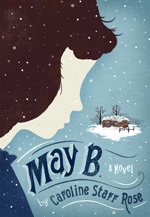 Debut author, Caroline Starr Rose, has created a riveting novel in verse about survival. Set in 19th century Kansas, May B and her family are struggling after a very tough and not so successful growing season. To help with family finances, May B’s parents hire her out as live-in help to the young newly wed neighbor couple that live fifteen miles away. As May B arrives at the little sod house she finds the new young bride so in the depths of unhappiness that she finally runs back to Ohio. Her husband sets out after her, leaving May B alone. As the days and weeks plod slowly by, May recognizes the fact she has been forgotten … abandoned and her family does not know that she is alone. Winter is fast approaching, and May has few supplies. A blizzard threatens as well as wolves and little food and the walls begin to psychologically close in on May so she has to figure out a way to stay safe as well as sane. A subplot to this survival verse tale is the fact that May is dyslexic. She has always had trouble in school, and she knows that missing all these months in the sod house will put her even further behind. How she tackles the loneliness and her reading difficulties combine to create a powerful story of survival. Teachers can download a study guide or use the book trailer from the author’s website.
Debut author, Caroline Starr Rose, has created a riveting novel in verse about survival. Set in 19th century Kansas, May B and her family are struggling after a very tough and not so successful growing season. To help with family finances, May B’s parents hire her out as live-in help to the young newly wed neighbor couple that live fifteen miles away. As May B arrives at the little sod house she finds the new young bride so in the depths of unhappiness that she finally runs back to Ohio. Her husband sets out after her, leaving May B alone. As the days and weeks plod slowly by, May recognizes the fact she has been forgotten … abandoned and her family does not know that she is alone. Winter is fast approaching, and May has few supplies. A blizzard threatens as well as wolves and little food and the walls begin to psychologically close in on May so she has to figure out a way to stay safe as well as sane. A subplot to this survival verse tale is the fact that May is dyslexic. She has always had trouble in school, and she knows that missing all these months in the sod house will put her even further behind. How she tackles the loneliness and her reading difficulties combine to create a powerful story of survival. Teachers can download a study guide or use the book trailer from the author’s website.
- Karen Hildebrand, Ohio Library and Reading Consultant
Winget, Dianna Dorisi. (2012). A smidgen of sky. New York: Harcourt Children’s Books.
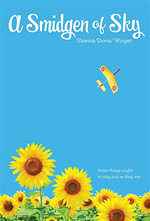 Ten-year-old Piper Lee DeLuna hasn’t forgotten her beloved father who disappeared during a plane crash four years ago, but apparently her mother has. When she decides to marry Ben, the man she has been dating, Piper plots to derail the wedding. Although she likes Ben, she just wants everything to stay the way it has been. But Piper’s plans to bring Ben's former wife back into the picture cause unexpected problems for everyone, especially for Ginger, Ben’s daughter. Suddenly, Piper finds that now that she has tried to fix things the way she wants them to be, she’s no longer in control of the results of her machinations. Readers will enjoy getting to know this willful, determined girl and empathize with her reluctance to let go of the possibility that her father is still alive while also knowing that she must move on with her life. As Piper realizes that she needs to be careful what she wishes for, she also learns to be content with what she has. The author has created an appealing cast of supporting characters to whom many readers can relate.
Ten-year-old Piper Lee DeLuna hasn’t forgotten her beloved father who disappeared during a plane crash four years ago, but apparently her mother has. When she decides to marry Ben, the man she has been dating, Piper plots to derail the wedding. Although she likes Ben, she just wants everything to stay the way it has been. But Piper’s plans to bring Ben's former wife back into the picture cause unexpected problems for everyone, especially for Ginger, Ben’s daughter. Suddenly, Piper finds that now that she has tried to fix things the way she wants them to be, she’s no longer in control of the results of her machinations. Readers will enjoy getting to know this willful, determined girl and empathize with her reluctance to let go of the possibility that her father is still alive while also knowing that she must move on with her life. As Piper realizes that she needs to be careful what she wishes for, she also learns to be content with what she has. The author has created an appealing cast of supporting characters to whom many readers can relate.
- Barbara A. Ward, Washington State University Pullman
GRADES 7-12
Abirached, Zeina. (2012). A game for swallows. Minneapolis: Lerner/Graphic Universe.
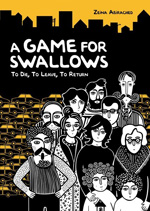 In the same way that Marjane Satrapi’s Persepolis (Pantheon, 2004) touched many hearts and informed many minds about Iran during the Islamic Revolution, this stunning graphic novel describes the lives of ordinary men, women, and children in war-torn Beirut, Lebanon, in 1984. Drawing from events in her own childhood, the author/illustrator describes one evening that typifies how her parents and neighbors came together during almost-impossible-to-imagine times when even a visit to someone two streets away could result in death from a sniper. When her parents are unable to return after visiting her grandmother, Zeina and her brother wait in the foyer of their apartment building, one of the only safe spots left. One by one, their neighbors come by to chat, offer comfort, and share food with the children. Even during this short period of time, the neighbors reveal heroic sides and concern for the children. The author chooses to use black and white panels to tell the story, perhaps to emulate the bleakness of those times and to allow the neighbors’ affectionate comments and actions to shine through the pages. Readers are unlikely to forget devoted Anhala, a family servant for three generations, left behind by those she served faithfully; enterprising Chucri who risks his life to find Zeina's parents; and Ernest Challita who quotes entire passages of Cyrano de Bergerac from memory, to the delight of the children, but who is unable to leave the apartment building after the death of his twin brother. The book helps readers imagine risking their lives to find ingredients for a recipe or to visit a relative. It also forces them to imagine a time when war and conflict have become the norm, and then to imagine the alternative--hiding safely away in an apartment, safe but barely living.
In the same way that Marjane Satrapi’s Persepolis (Pantheon, 2004) touched many hearts and informed many minds about Iran during the Islamic Revolution, this stunning graphic novel describes the lives of ordinary men, women, and children in war-torn Beirut, Lebanon, in 1984. Drawing from events in her own childhood, the author/illustrator describes one evening that typifies how her parents and neighbors came together during almost-impossible-to-imagine times when even a visit to someone two streets away could result in death from a sniper. When her parents are unable to return after visiting her grandmother, Zeina and her brother wait in the foyer of their apartment building, one of the only safe spots left. One by one, their neighbors come by to chat, offer comfort, and share food with the children. Even during this short period of time, the neighbors reveal heroic sides and concern for the children. The author chooses to use black and white panels to tell the story, perhaps to emulate the bleakness of those times and to allow the neighbors’ affectionate comments and actions to shine through the pages. Readers are unlikely to forget devoted Anhala, a family servant for three generations, left behind by those she served faithfully; enterprising Chucri who risks his life to find Zeina's parents; and Ernest Challita who quotes entire passages of Cyrano de Bergerac from memory, to the delight of the children, but who is unable to leave the apartment building after the death of his twin brother. The book helps readers imagine risking their lives to find ingredients for a recipe or to visit a relative. It also forces them to imagine a time when war and conflict have become the norm, and then to imagine the alternative--hiding safely away in an apartment, safe but barely living.
- Barbara A. Ward, Washington State University Pullman
Cushman, Karen. (2012). Will Sparrow’s road. New York/Boston: Houghton Mifflin Harcourt/Clarion Books.
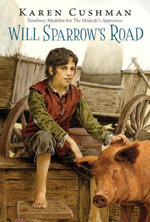 In Elizabethan England, twelve-year-old Will Sparrow, who calls himself a liar and a thief out of necessity, runs away from the abusive innkeeper to whom his father sold him to pay off his drinking debts. After enduring betrayal after betrayal from those he encounters on the road, Will ends up traveling with a band of "oddities and prodigies" (p. 209) who are a part of the open-air fairs that spring up near large cities and towns. Not only can attendees purchase food, but they can also amuse themselves by staring at three-legged chickens and a baby mermaid in a jar. Although at first frightened by the unusual looks of Grace, a girl whose furry face makes her resemble a cat, and the short-statured Fitz, Will eventually realizes that Master Tidball, who owns the troupe, is the one who deserves his contempt since he mistreats the members of his traveling band and has made up many of the oddities on display. The title captures the flavor of those times perfectly, describing Will's desperate search for food to fill his belly, and the affection he finds while taking care of Duchess, a pig who is smarter than most of those around her. Will's understandable mistrust of others gradually disappears once he finds trustworthy individuals and a created family. While characters enter the story and disappear quickly, such was the way centuries ago, and someone who seemed likely to be a friend might end up stealing that last morsel of food out of necessity.
In Elizabethan England, twelve-year-old Will Sparrow, who calls himself a liar and a thief out of necessity, runs away from the abusive innkeeper to whom his father sold him to pay off his drinking debts. After enduring betrayal after betrayal from those he encounters on the road, Will ends up traveling with a band of "oddities and prodigies" (p. 209) who are a part of the open-air fairs that spring up near large cities and towns. Not only can attendees purchase food, but they can also amuse themselves by staring at three-legged chickens and a baby mermaid in a jar. Although at first frightened by the unusual looks of Grace, a girl whose furry face makes her resemble a cat, and the short-statured Fitz, Will eventually realizes that Master Tidball, who owns the troupe, is the one who deserves his contempt since he mistreats the members of his traveling band and has made up many of the oddities on display. The title captures the flavor of those times perfectly, describing Will's desperate search for food to fill his belly, and the affection he finds while taking care of Duchess, a pig who is smarter than most of those around her. Will's understandable mistrust of others gradually disappears once he finds trustworthy individuals and a created family. While characters enter the story and disappear quickly, such was the way centuries ago, and someone who seemed likely to be a friend might end up stealing that last morsel of food out of necessity.
- Barbara A. Ward, Washington State University Pullman
Demi. (2012). Columbus. New York: Amazon Children’s Publisher.
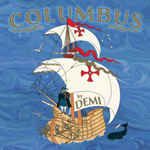 In Demi’s characteristic style using Chinese paintbrushes, ink, and gold overlays she has told the story of Christopher Columbus. In the introduction she discusses reading hundreds of books about Columbus and early navigation to write this authentic account of Columbus’s search for the riches of the East. Thinking he would become rich by sailing from Europe and traveling east, he would navigate his way to China and India. The rest, of course, is history. As Columbus anchors his ships he is opening the threshold to the so-called New World. Using marbled paper imported from Florence, Italy, Demi has written and illustrated a beautiful version of this early explorer. Learn more about this author/illustrator online. ReadWriteThink offers a lesson idea entitled “Columbus Day is Recognized Today.”
In Demi’s characteristic style using Chinese paintbrushes, ink, and gold overlays she has told the story of Christopher Columbus. In the introduction she discusses reading hundreds of books about Columbus and early navigation to write this authentic account of Columbus’s search for the riches of the East. Thinking he would become rich by sailing from Europe and traveling east, he would navigate his way to China and India. The rest, of course, is history. As Columbus anchors his ships he is opening the threshold to the so-called New World. Using marbled paper imported from Florence, Italy, Demi has written and illustrated a beautiful version of this early explorer. Learn more about this author/illustrator online. ReadWriteThink offers a lesson idea entitled “Columbus Day is Recognized Today.”
- Karen Hildebrand, Ohio Library and Reading Consultant
Haddix, Margaret Peterson. (2012). Caught. New York: Simon & Schuster.
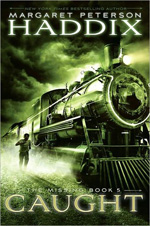 Caught is Book 5 in the author’s The Missing series. The story opens when time unexplainably and suddenly freezes. Katherine and Jonah are thrown back in time to the year 1903. As events spin by they are confronted with the first wife of Albert Einstein, Mileva. She has grabbed the Elucidator and will not give it back until she knows more about their time traveling and how it is done. Mileva’s young daughter, Lieserl, has scarlet fever and she thinks medicines of the future can save her. The disappearance of this daughter from the annals of history has always been a mystery and now Katherine and Jonah know that they cannot change history, especially in light of Albert Einstein’s world-renowned scientific contributions. Haddix has included at the end of the book her Author’s Notes to talk about discerning the fact from fiction in a book that plays with historical fact, especially where time travel is involved. An excerpt and book trailer are available at the publisher’s website. Learn more about the author and her other popular books at her website. “Looking for the History in Historical Fiction: An Epidemic for Reading” is a lesson plan idea from ReadWriteThink.
Caught is Book 5 in the author’s The Missing series. The story opens when time unexplainably and suddenly freezes. Katherine and Jonah are thrown back in time to the year 1903. As events spin by they are confronted with the first wife of Albert Einstein, Mileva. She has grabbed the Elucidator and will not give it back until she knows more about their time traveling and how it is done. Mileva’s young daughter, Lieserl, has scarlet fever and she thinks medicines of the future can save her. The disappearance of this daughter from the annals of history has always been a mystery and now Katherine and Jonah know that they cannot change history, especially in light of Albert Einstein’s world-renowned scientific contributions. Haddix has included at the end of the book her Author’s Notes to talk about discerning the fact from fiction in a book that plays with historical fact, especially where time travel is involved. An excerpt and book trailer are available at the publisher’s website. Learn more about the author and her other popular books at her website. “Looking for the History in Historical Fiction: An Epidemic for Reading” is a lesson plan idea from ReadWriteThink.
- Karen Hildebrand, Ohio Library and Reading Consultant
Hale, Shannon. (2012). Princess academy: Palace of stone. New York: Bloomsbury.
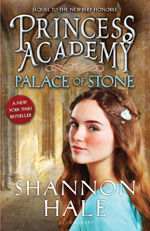 Miri and the cast of characters from the original Princess Academy are back and are traveling to Asland, the capital city of Danland. Miri has decided to attend the university with the intention of becoming a teacher and returning to her beloved Mt. Eskel to teach the children and villagers not only to read, but also to learn the history of their mountain and the entire country. While Miri fits into city and university life, she makes new friends, including a young man, Timon, who introduces her to a politically new way of thinking about life in their country. Her eyes are opened to the many injustices done to the common people. While this is going on she is also making herself available to Britta as she prepares to become the wife and princess to young Prince Steffan. Peder has also come to the city to apprentice to a stone carver. Miri’s special feelings for Peder get confused after meeting Timon and she starts to seriously question where her place in the future will be. The story takes a dramatic turn when revolution breaks out and Miri is forced to make many life-altering decisions quickly. Learn more about the author in "5 Questions With... Shannon Hale" on the Engage blog, and watch the book trailer and learn more about the author and her other books at her website.
Miri and the cast of characters from the original Princess Academy are back and are traveling to Asland, the capital city of Danland. Miri has decided to attend the university with the intention of becoming a teacher and returning to her beloved Mt. Eskel to teach the children and villagers not only to read, but also to learn the history of their mountain and the entire country. While Miri fits into city and university life, she makes new friends, including a young man, Timon, who introduces her to a politically new way of thinking about life in their country. Her eyes are opened to the many injustices done to the common people. While this is going on she is also making herself available to Britta as she prepares to become the wife and princess to young Prince Steffan. Peder has also come to the city to apprentice to a stone carver. Miri’s special feelings for Peder get confused after meeting Timon and she starts to seriously question where her place in the future will be. The story takes a dramatic turn when revolution breaks out and Miri is forced to make many life-altering decisions quickly. Learn more about the author in "5 Questions With... Shannon Hale" on the Engage blog, and watch the book trailer and learn more about the author and her other books at her website.
- Karen Hildebrand, Ohio Library and Reading Consultant
These reviews are submitted by members of the International Reading Association's Children's Literature and Reading Special Interest Group (CL/R SIG) and are published weekly on Reading Today Online
. The International Reading Association partners with the National Council of Teachers of English and Verizon Thinkfinity to produce ReadWriteThink.org, a website devoted to providing literacy instruction and interactive resources for grades K–12.